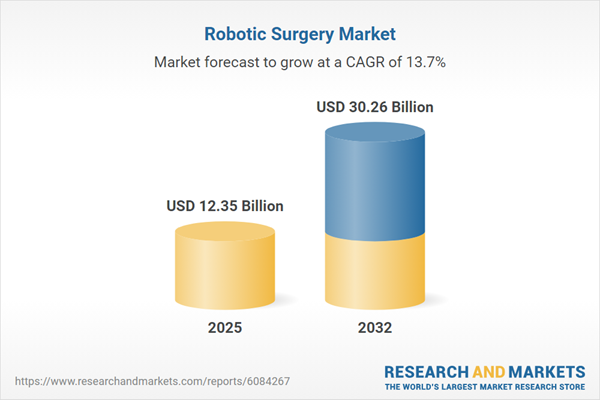Speak directly to the analyst to clarify any post sales queries you may have.
The robotic surgery market is rapidly transforming surgical care through next-generation platforms, reshaping clinical protocols, procurement strategies, and workforce development across health systems globally.
Market Snapshot
The Robotic Surgery Market grew from USD 10.84 billion in 2024 to USD 12.35 billion in 2025, and is projected to reach USD 30.26 billion by 2032, reflecting a robust CAGR of 13.69%.
Consistent investments and innovation are fueling adoption as healthcare providers seek enhanced precision, efficiency, and integration within modern operating environments.Scope & Segmentation
- Product Types: Instruments and Accessories (including endoscopic cameras, articulated wristed tools, energy delivery devices, surgical staplers); Services (consulting, maintenance and repair, training and education); Systems (multi-arm system, single-arm system)
- Clinical Applications: Cardiothoracic surgery, General surgery, Gynecology, Neurosurgery, Orthopedics, Urology
- End Users: Ambulatory surgical centers, Hospitals
- Technologies: Multi-port, Single-port (including established dedicated systems, next-generation platforms such as Da Vinci SP)
- Regions: Americas (United States, Canada, Mexico, Brazil, Argentina, Chile, Colombia, Peru), Europe Middle East & Africa (United Kingdom, Germany, France, Russia, Italy, Spain, Netherlands, Sweden, Poland, Switzerland, UAE, Saudi Arabia, Qatar, Turkey, Israel, South Africa, Nigeria, Egypt, Kenya), Asia-Pacific (China, India, Japan, Australia, South Korea, Indonesia, Thailand, Malaysia, Singapore, Taiwan)
- Leading Companies: Intuitive Surgical, Stryker, Medtronic, Zimmer Biomet, Johnson & Johnson, Globus Medical, Asensus Surgical, CMR Surgical, Smith & Nephew, Renishaw
Key Takeaways
- Integration of articulated instruments, advanced imaging, and ergonomic consoles is driving a sustainable shift in procedural planning, execution, and outcome consistency across surgical departments.
- Procurement decisions increasingly factor in service networks, maintenance models, and robust educational pathways, instead of focusing solely on device specifications.
- Healthcare organizations face pivotal choices in platform modularity and instrument versatility, with an eye toward lifecycle management and scalability across diverse clinical environments.
- Innovations such as AI-enabled imaging, tele-mentoring, and remote proctoring enhance collaboration and facilitate new models for cross-institutional skill building and oversight.
- Emerging vendors and modular systems are intensifying competition, prompting the need for comparative data and strategic partnerships to validate value and support informed decision-making.
Tariff Impact
Recent 2025 U.S. tariff adjustments introduce operational complexity for those sourcing or distributing robotic surgical systems and consumables. These shifts influence cross-border pricing, supply-chain strategies, and inventory policies. Stakeholders are adapting manufacturing locations, component sourcing, and developing value-based procurement models to absorb and manage variable costs. The tariff landscape reinforces the need for supply-chain resilience and flexible service agreements to support sustained surgical operations.
Methodology & Data Sources
This report uses a multi-method approach, integrating primary interviews with surgeons, procurement leaders, and vendor executives, plus on-site observations and secondary literature reviews. Systematic data triangulation and expert validation underpin robust, defensible conclusions to ensure clarity for decision-makers.
Why This Report Matters
- Supports capital allocation and procurement strategies by delineating how product selection, training, and service depth shape operational and financial outcomes.
- Equips stakeholders with insights into regional adoption trends, technology benchmarks, and emerging market opportunities.
- Recommends practical actions for aligning technology choices with evolving clinical needs, organizational priorities, and risk management requirements.
Conclusion
Robotic surgery’s continued evolution requires alignment of technology, training, and procurement to maximize clinical and operational value. For optimal outcomes, organizations should prioritize evidence-based adoption, agile partnership models, and resilient sourcing frameworks as the sector matures.
Table of Contents
3. Executive Summary
4. Market Overview
7. Cumulative Impact of Artificial Intelligence 2025
Companies Mentioned
The companies profiled in this Robotic Surgery market report include:- Intuitive Surgical, Inc.
- Stryker Corporation
- Medtronic plc
- Zimmer Biomet Holdings, Inc.
- Johnson & Johnson Services, Inc.
- Globus Medical, Inc.
- Asensus Surgical, Inc.
- CMR Surgical Ltd
- Smith & Nephew plc
- Renishaw plc
Table Information
| Report Attribute | Details |
|---|---|
| No. of Pages | 181 |
| Published | October 2025 |
| Forecast Period | 2025 - 2032 |
| Estimated Market Value ( USD | $ 12.35 Billion |
| Forecasted Market Value ( USD | $ 30.26 Billion |
| Compound Annual Growth Rate | 13.6% |
| Regions Covered | Global |
| No. of Companies Mentioned | 11 |









